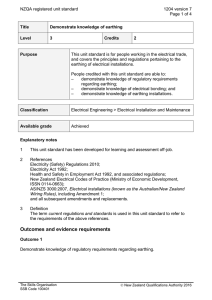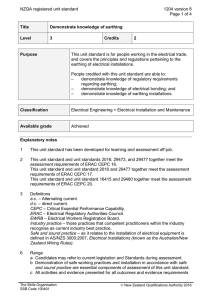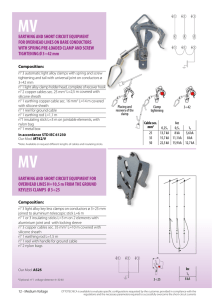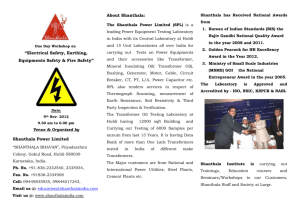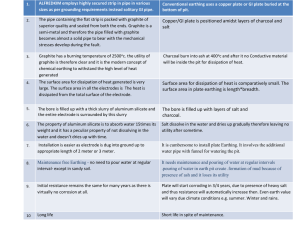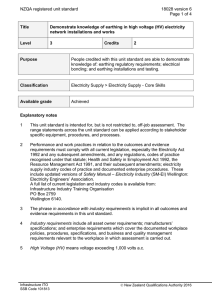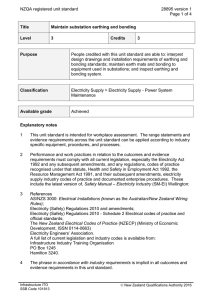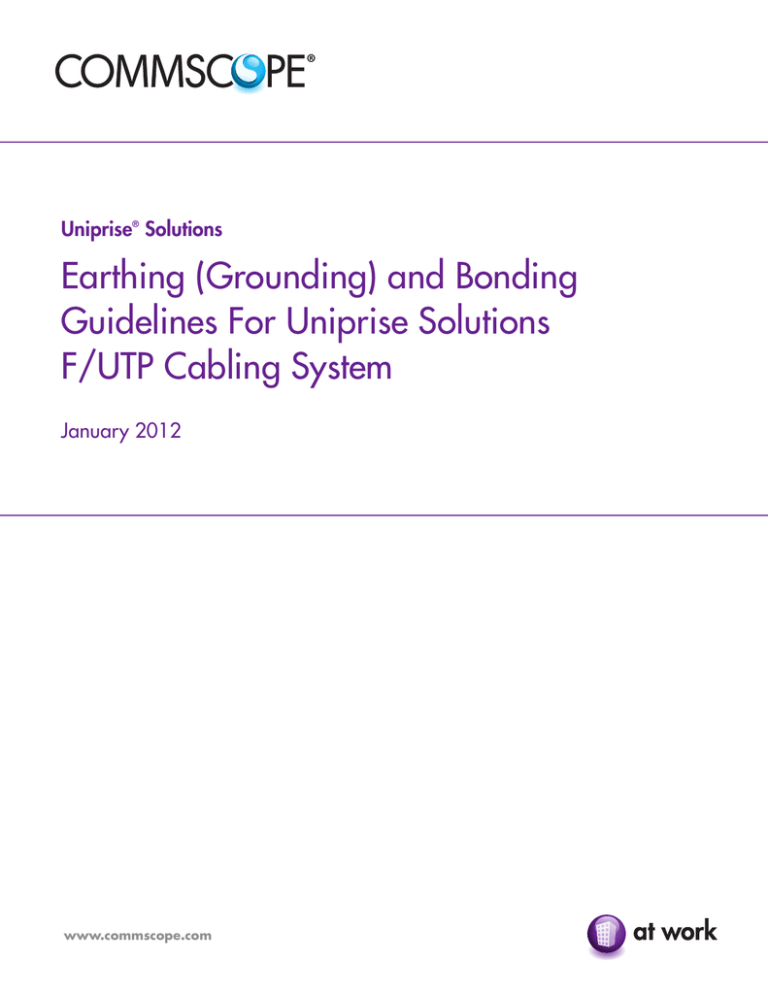
Uniprise® Solutions
Earthing (Grounding) and Bonding
Guidelines For Uniprise Solutions
F/UTP Cabling System
January 2012
www.commscope.com
Contents
Contents
1.0 Introduction 3
2.0 Earthing and Bonding 3
3.0 Earthing of Uniprise Solutions F/UTP Cabling System 5
4.0 Earthing of Equipment Cabinet/Rack 9
5.0 Operations Considerations 11
www.commscope.com
2
1.0 Introduction
The earthing (grounding) and bonding of Uniprise Solutions F/UTP cabling system in customer
premises shall follow national and/or local electrical codes/standards if these codes/
standards exist. Examples of these codes are NFPA 70/NEC (USA), BS 7671 (UK IEE Wiring
Regulations) and VDE 0100 (Germany). Examples of these standards are ANSI/TIA/ EIAJSTD-607-B, ANSI/TIA/EIA-568-C (USA), EN 50174-2 and EN 50310 (Europe) and
IEC 60364-5-548 (International).
In this document, earthing is synonymous to grounding.
The IEC technical report TR 61000-5-2 and ANSI/TIA/EIA-J-STD-607-A provide useful
guidelines for the earthing and bonding of electrical and electronic systems and installations.
This document is aimed at ensuring personnel safety and electromagnetic compatibility (EMC)
among electrical and electronic equipment or systems.
This document outlines the earthing and bonding of the Uniprise Solutions F/UTP and cabling
system in customer premises in relation to safety, functional and electromagnetic performance and
shall be used where specific national and/or local electrical codes/standards do not supersede.
The aim of the document is to achieve the following needs:
•Safety from electrical hazards
•Reliable signal reference within the network
•Satisfactory and/or enhanced electromagnetic performance for the network
2.0 Earthing and Bonding
It is important to remember that safety procedures for personnel protection will take precedence
over EMC protection procedures. The primary goal of an earthing system is to assure personnel
safety and protection of installations against damage. Two important phenomena are lightning
and power system faults. These can cause circulation of large currents, which may create
hazardous voltages in the installation. For lightning, the task of the earthing system is to provide
a path to the soil for dangerous currents, while maintaining potential differences between any
two points of an installation as low as possible. For power system faults, it provides a safe path
for fault currents, while also maintaining potential differences between any two points of an
installation as low as possible. Typically, fault currents will then trip circuit breakers to remove
power. Generally, national or local regulations specify maximum voltage values for personnel
safety including provision for protective earth (PE) conductor practices.
www.commscope.com
3
The PE is a network of conductors that carry the currents related to safety to the main earth
terminal. The main earth terminal is the point inside the building where all earth connections are
gathered and where a physical connection to earth ground can be verified and assured.
However, these PE conductors alone are generally not sufficient to fulfill the EMC requirements.
Low noise can only be achieved with the TN-S electrical distribution network. In a TN-S
configuration, the neutral (N) and PE conductors are routed separately as from the transformer
or the feeding point and a continuous 5-conductor network L1/L2/L3/N/PE must exist in the
building. The TN-S configuration is required for optimum EMC performance. With this, all
power currents and voltages are normally isolated from the PE and from the rest of the earthing
system in the building.
TR 61000-5-2 and ANSI/TIA/EIA-J-STD-607-B specify additional earthing conductors
and specific interconnection components and methods that augment the existing earthing
system. This Telecommunications Earthing System provides an explicit earthing network that
telecommunications installers can verify for personal safety and that minimizes interference
from other building systems or equipment. Thus, a Telecommunications Earthing System
allows telecommunications personnel to manage safety and performance in a way that
is far less dependent on other building operations. Cable screens must be earthed to the
Telecommunications Earthing System as outlined below.
Each telecommunications room of a building must have a connection point to the
Telecommunications Earthing System to allow for bonding of equipment or systems, metallic
cable baskets/trays, metallic water pipes, metallic floor tiles, racks, frames, etc. It is
recommended to connect the various apparatus at the nearest connection point of this system
in order to improve the EMC performance of an installation. These connection points should be
sufficiently close to provide low impedance bonding. All earth connections should be kept as
short and straight as possible to avoid creating a high impedance path.
www.commscope.com
4
3.0 Earthing of Uniprise Solutions F/UTP Cabling System
The Uniprise F/UTP cabling solution is an end-to-end system consisting of F/UTP cables, F/UTP
cords, F/UTP outlet connectors and F/UTP patch panels. Table 1 provides a list of the various
components. The cabling shall be installed according to the latest Uniprise F/UTP Solution
Design and Installation Guidelines.
Table 1: UNIPRISE SOLUTIONS F/UTP COMPONENTS
Cable
Category 5e
Category 6
5ENS4 (CMR), 5ES4 (CMP)
65NS4+ (CMR), 65S4+ (CMP)
Cord
FTP-PC5E-GYx
FTP-PC6-GYx
Connector
FTP-J5E
FTP-J6
Patch Panel
M3200
M3200
For Uniprise Solutions F/UTP cable, the foil and the drain wire (also referred to as a bonding
conductor) are both conductive. A connection can be realized by folding the foil back over the
outer sheath such that the metallic part of the foil makes contact with the metallic surface of the
rear opening of the connector housing. This connection ensures high frequency performance.
This must also be supported by connecting the drain wire to the bonding contact of the FTP-J5E
and FTP-J6 connectors. This connection ensures a direct connection through to the shielded
plugs. The metalized housing provides the bonding connection to the F/UTP patch panel.
Earthing studs are available at the back of the F/UTP patch panel (See Figure 1).
Figure 1: Connecting the Ground Strap to the Earthing Stud on the Back
of the Panel
www.commscope.com
5
Figure 2: Connection to Ground Strap to Rail of Frame Using Paint
Scraping Washer
Figure 3: Daisy Chaining of Ground Straps is Not Allowed.
www.commscope.com
6
The individual panels must all be earthed. This may be accomplished by connecting a ground
cable from the grounding stud of each individual panel to the rack. The minimum conductor size
shall be AWG 12 or 4 mm2. The length of the bonding conductor should be as short as practical.
For example, when bonding to the rack, the length should not be greater than 150 mm (6 inches).
In the case of cabinets with a horizontal bus-bar at the bottom, the bonding conductor may
be as long as 2 m (7 feet). Since the racks are generally painted with non-conductive paint, a
paint scraping washer, must be used to ensure low impedance earthing contact. In some cases,
and per European standards, the grounding of the cabinet rail may not be assumed, and one
of the following methods should be used. The panels may be earthed by installing a ground
cable from the panel earthing studs to a suitable vertical earthing bus-bar mounted within a
cabinet/rack (figure 4) or to several earth terminal blocks mounted to the cabinet/rack vertical
equipment mounting rail (Figure 5). The daisy-chaining of the panel grounding studs (figure 3)
is not permitted. The earth terminal blocks shall be connected together using 14 mm2 (6 AWG)
insulated copper earth wires.
Figure 4: Use of Vertical Grounding Bus-Bar
www.commscope.com
7
Another method to ground the panels is the use of earthing terminals, with ground straps
connected to each of the earthing terminals, and with the earthing terminals connected by
a larger grounding strap to the telecommunications grounding bus-bar. See figure 5.
Figure 5: Panels Grounded to Earthing Terminals, Then to the
Telecommunications Grounding Bus-Bar
All earth connections shall be crimped or screwed using components approved for the purpose.
The equipment cabinet/rack shall be earthed (see section 4.0).
Earthing of equipment at the work area is usually accomplished through the PE conductor of the
equipment power connection. If present, screen connections to the work area equipment shall be
accomplished through the screen of the FTP-PC5E-GYx and FTP-PC6-GYx work area patch cords
extending from the Telecommunications Outlet (TO) to the equipment through the shielded modular
jack contacts. Except when required by national/local code, the TO connector screen conductor
should not be bonded to earth in the work area by any means other than through the screen of
the FTP- PC5EGYx and FTP-PC6-GYx work area patch cords extending from the TO to equipment.
In some countries it is recommended to ground the TO directly according to local code.
www.commscope.com
8
4.0 Earthing of Equipment Cabinet/Rack
The equipment cabinet/rack shall be earthed so that voltages that are induced into cabling
(by lightning or other disturbances) are directed to earth (see Figure 2).
•Earthing shall be in accordance with applicable national or local electrical codes.
•The earth path shall be permanent and continuous.
•If multiple cabinets/racks are located within one area, a telecommunication earthing busbar
shall be fitted within the area. This busbar shall be a predrilled copper busbar provided
with holes for use with standard size lugs. It shall be at least 6 mm thick, 100 mm wide and
variable in length. The length of the busbar shall be sufficient for the immediate requirements
and have at least a 20% allowance for future growth. The busbar shall be isolated from its
mounting point (a 50 mm separation is recommended) and a bonding connection made to
the room’s power service earth and the closest accessible building steel. If multiple cabinets/
racks exist, each cabinet/rack shall be connected to the telecommunication earthing bar
separately. This assures the continuity of the earth path from each cabinet/rack. Serial
connection between cabinets/racks is not recommended. However, equipment vendors
may require direct bonding between cabinets, but this must not be in place of the busbar
connections.
•All the insulated earth wires shall be connected to the telecommunication earthing bar and
must not be coiled or doubled-back on themselves. These wires shall have the following
dimensions:
oo A minimum size of 25 mm2 (3 AWG) for installations where no or a poor protective earth
system exist (for example, in old buildings). The maximum length is 4 meters (13 feet).
Larger size earth wires shall be used if the length is greater than 4 meters.
oo A minimum size of 14 mm2 (6 AWG) for any other installations where a good protective
earth system exist (for example, in buildings with a telecommunications earthing system).
The maximum length is 4 meters (13 feet). Larger size earth wires shall be used if the
length is greater than 4 meters.
www.commscope.com
9
If the telecommunication earthing busbar is located under a raised floor or above a false
ceiling, an identification label shall be fixed to the floor or ceiling tile and to an adjacent wall
to identify its position. The location of the telecommunication earthing busbar shall be such that
it is accessible.
Figure 6: Earthing and Bonding of Equipment Cabinets/Racks
www.commscope.com 10
5.0 Operations Considerations
The grounding and bonding system should be maintained and monitored to ensure that it
continues to provide good functional performance.
There are several evaluation methods, tools, and standards that may be used to understand
and monitor this performance. CommScope recommends that these tools and methods be used
to verify performance on a continual basis.
For example current probes may be used to measure the ground current in different bonding/
earth conductors to gain insights into fault conditions as well as normal performance.
To ensure there are no ground loops, the voltage between any two points of a grounding
system should not be greater than 1 V rms. For example, a measurement of greater than 1 V
between the TO shield and the ground conductor of a power outlet in close proximity indicates
that there is a problem with the grounding system that should be corrected.
A Residual End Operating Current (RCM) surveillance system may be deployed to continually
monitor the current in the grounding system and generate alarms if the ground current exceeds
the system threshold.
More information on grounding and bonding including operations considerations is available
in EN 50310, EN 50174-2, IEC 60365-5-54, and ANSI/TIA-607-B.
References
EN 50310 Application of equipotential bonding and earthing in buildings
with information technology equipment
EN 50174-2 Information Technology – Cabling installation – Part 2:
Installation planning and practices inside buildings
IEC TR 61000-5-2 Installation and mitigation guidelines – Earthing and cabling
IEC 60364-5-54Low-voltage electrical installations – Part 5-54: Selection and
erection of electrical equipment – Earthing arrangements,
protective conductors and protective bonding conductors
IEC 60364-4-444Low-voltage electrical installations – Part 4-444: Protection
for safety – Protection against voltage disturbances and
electromagnetic disturbances
IEC 60364-5-548 Earthing arrangements and equipotential bonding for
information technology installations
ANSI/TIA-607-BCommercial building grounding and bonding requirements for
Telecommunications
ANSI/TIA/EIA-568-C.0
www.commscope.com
Visit our Web site or contact your local
CommScope representative for more information.
© 2011 CommScope, Inc. All rights reserved.
All trademarks identified by ® or ™ are registered
trademarks or trademarks, respectively, of CommScope, Inc.
This document is for planning purposes only and is not
intended to modify or supplement any specifications or
warranties relating to CommScope products or services.
TD-B-1 01/12
Generic Telecommunications Cabling for Customer Premises
ETSI EN 300253Environmental Engineering (EE); Earthing and bonding of
telecommunication equipment in telecommunication centers

